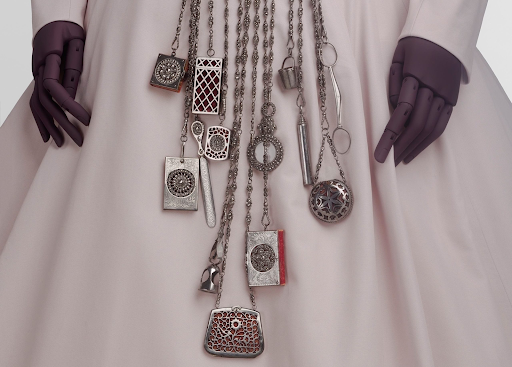From Medieval Nobility to Modern-Day Flexes
Darlings, today I will be gracing you with a little fashion history lesson. Especially, since a specific trend has recently caught my attention and this has everything to do with what is on your bag, rather than what is in it. Back, and I mean way back… like make it in the 13th–14th centuries, nobles weren’t subtle. They clipped ornate coin pouches, girdle books, and tassels onto belts and chatelaine bags to telegraph their power, wealth, and lineage. Sumptuary laws even banned commoners from mimicking these flair badges—nobles had to flaunt, peasants sat still. This my darlings is called: The Chatelain Era.
Chatelaine, 1863 – 1885, probably England. Museum no. M.32:1 to 13-1969. © Victoria and Albert Museum, London
Photo: Messy Nessy Chic
Fast-forward to today, and guess what? The same logic still applies when influencers layer their totes with designer charms, fuzzy toys, or luxury brand keychains only now, slapping plush toys, crystals, and character keychains on our Louis Vuittons and Hersheys. It's cute, but is it culture? Or just capitalism’s latest rabbit hole?
The Personality vs. Plastic Debate
Trend articles love to say bag charms = personal expression. And sure, the idea of subverting high-priced leather with a Jigglypuff keyring can feel rebellious. But the game is rigged: mass-produced charms sell, so even the "quirky" ones often lean into safe, oversaturated vibes.
Consider the meteoric rise of Labubus, you know those creepy little things hanging off people’s bags? Those quirky elf plushie gripping Birkins across feeds? They’re playful, seemingly unserious and utterly orchestrated by TikTok algorithms and mega brands like Pop Mart and Balenciaga.
Gen Z’s “Labubu” gremlin or plush keychain is the new badge of irreverent individuality Sure, a teddy charm says, “cuddly personality,” but slap a Hermès charm next to it, and suddenly it’s “look at me, I have taste…and money.”
Luxury brands are leaning in: Coach, Burberry, Versace they’re all cashing in on this mini-statement gold rush, selling charms for the price of a small dinner ticket.
Photo: Pinterest
Welcome to the charm industrial complex, where self-expression and brand promotion walk hand-in-hand.
Climbing the Capitalism Rabbit Hole—With Glitter
It starts whimsical—a fun charm, a nod to nostalgia (Y2K vibes, bodega spoons, the works).
Upgrades to deluxe—next step, is giving your Labubu a bit more personality, like dressing it up or giving him a new companion (another Labubu)
Then you wake up to find your 30-pound tote filled with charms you don’t even remember buying and sponsored content calling it “self-portrait shell accessories.”
The line between personality flex and capitalist compulsion gets blurry faster than you can hit “Add to Cart.”
So, What Should You Do?
Choose with intention: Skip impulse buys. Pick charms that spark memories or serve as talismans.
Curate don’t collect: Limit yourself to 2–3 meaningful pieces, not 20 viral trinkets.
Support small creators: Not everything has to be a mass-produced brand drop. Etsy, community artisans—they have soul in spades.
Final Sass: Charm Responsibly
So go ahead, grab the furry gremlin, the vintage camera, or don’t. Just remember when you start stacking charms, you’re weaving your identity and their marketing scheme. Medieval nobles might’ve worn their gold because they had to but today, if you're wearing charm "status," ask whether you're in control or just another post-charmed product.
In the end: accessorize with intention. Or risk turning your bag into a billboard you didn’t even write.
XOXO, The Fashion Stock Market.
Cover Photo: Pinterest
Editor: Felicity Field

